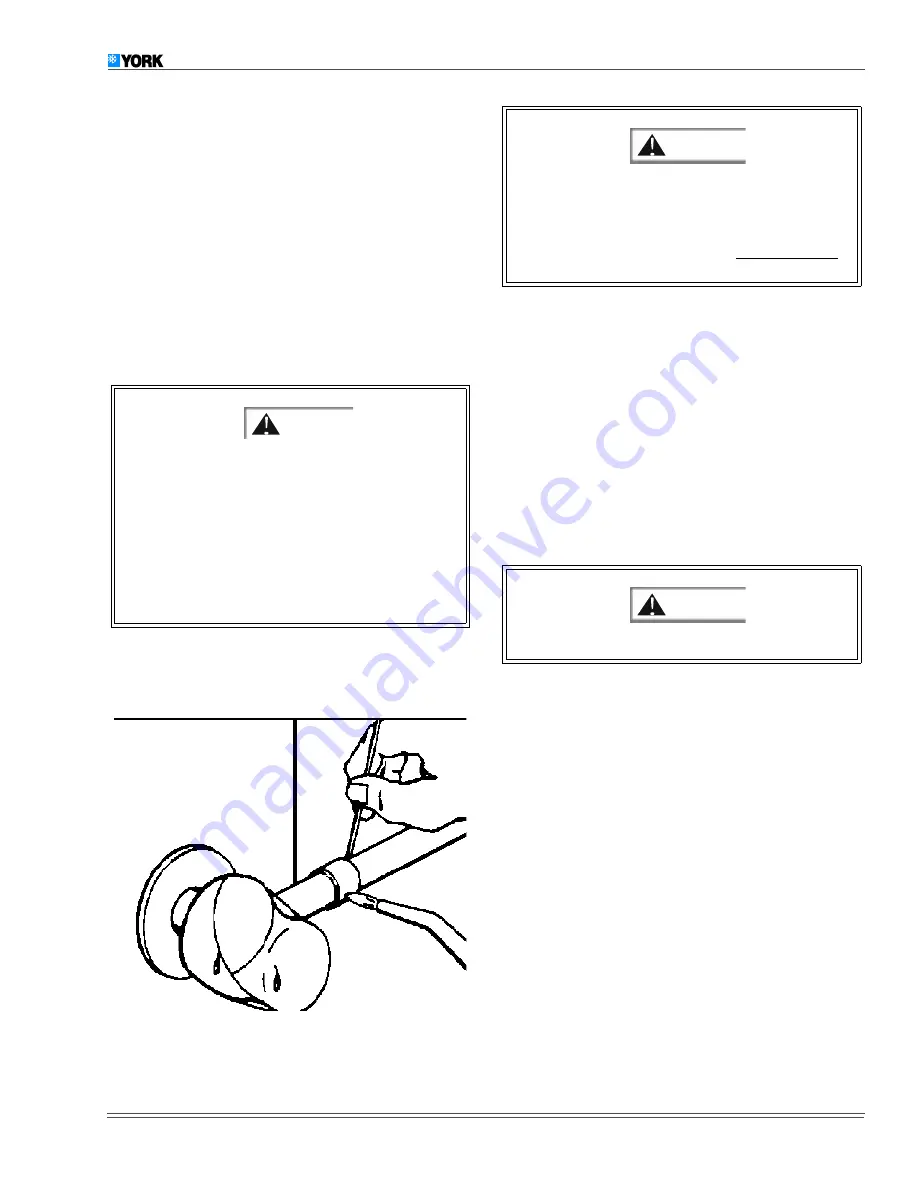
035-14511-000 REV B (1299)
Unitary Products Group
6
®
The outdoor units have re-usable service valves on both the
liquid and vapor connections. The total system refrigerant
charge is retained within the outdoor unit during shipping and
installation. The re-usable service valves are provided to
evacuate and charge per this instruction.
Serious service problems can be avoided by taking adequate
precautions to assure an internally clean and dry system.
PRECAUTIONS DURING BRAZING ANGLE VALVE
Precautions should be taken to prevent heat damage to
angle valve by wrapping a wet rag around it as shown in Fig-
ure 5. Also, protect all painted surfaces and insulation during
brazing. After brazing - cool joint with wet rag.
Valve can be opened by removing the plunger cap and fully
inserting a hex wrench into the stem and backing out counter-
clockwise until valve stem just touches retaining ring.
Replace plunger cap finger tight, then tighten an additional 1/
12 turn (1/2 hex flat). Cap must be replaced to prevent leaks.
Connect the refrigerant lines using the following procedure:
1.
Remove the cap and Schrader core from both the liquid
and vapor angle valve service ports at the outdoor unit.
Connect low pressure nitrogen to the liquid line service
port.
2.
Braze the liquid line to the liquid valve at the outdoor
unit. Be sure to wrap the valve body with a wet rag. Allow
the nitrogen to continue flowing.
3.
Carefully remove the rubber plugs from the evaporator
liquid and vapor connections.
4.
Braze the liquid line to the evaporator liquid connection.
The nitrogen should now be flowing through the evaporator
coil.
5.
Slide the grommet away from the vapor connection at
the coil. Braze the vapor line to the evaporator vapor
connection. After the connection has cooled, slide the
grommet back into original position.
6.
Protect the vapor valve with a wet rag and braze the
vapor line connection. The nitrogen flow should be exit-
ing the system from the vapor service port connection.
After this connection has cooled, remove the nitrogen
source from the liquid fitting service port.
7.
Evacuate the vapor line, evaporator and the liquid line, to
500 microns or less.
8.
Leak test all refrigerant piping connections including the
service port flare caps to be sure they are leak tight. DO
NOT OVERTIGHTEN (between 40 and 60 inch - lbs.
maximum).
NOTE: Do not use the system refrigerant in the outdoor unit to
purge or leak test.
This is not a backseating valve. The service access
port has a valve core. Opening or closing valve does
not close service access port.
If the valve stem is backed out past the retaining ring,
the O-ring can be damaged causing leakage or sys-
tem pressure could force the valve stem out of the
valve body possibly causing personal injury. In the
event the retaining ring is missing, do not attempt to
open the valve.
FIGURE 5 :
HEAT PROTECTION
WARNI
If visual verification of the valve stem reaching the
retaining ring is impossible, stop backing out the.valve
stem when the slightest increase in resistance is felt.
Because of the small size and therefore the reduced
resistance, back out the liquid valve 5 turns maximum
to prevent going past the retaining ring.
The evaporator is pressurized.
CAUTIO
CAUTIO


































